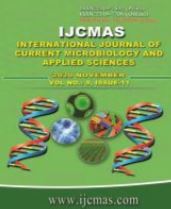


 National Academy of Agricultural Sciences (NAAS)
National Academy of Agricultural Sciences (NAAS)

|
PRINT ISSN : 2319-7692
Online ISSN : 2319-7706 Issues : 12 per year Publisher : Excellent Publishers Email : editorijcmas@gmail.com / submit@ijcmas.com Editor-in-chief: Dr.M.Prakash Index Copernicus ICV 2018: 95.39 NAAS RATING 2020: 5.38 |
The present study was conducted to assess the impact of different land-use systems on major nutrient status viz: Nitrogen, Phosphorus and Potassium in soils of central part of Western ghat, Karnataka. The land use types include both manmade systems (Agriculture: paddy; Horticulture: coffee, are canut, tea and banana); forest plantation (accacia and teak) and natural systems (Evergreen, semi-evergreen and grassland). In each land use systems, samples were collected from two depths (0-15 cm and 15-30 cm) at 20 locations during pre-monsoon and post monsoon period. Soil samples were analyzed for available nitrogen, available phosphorus and available potassium. The results revealed that available nitrogen content in surface soil was significantly higher (394.55 kg ha-1) than that of subsurface soil (330.57 kg ha-1). Among manmade land use systems, available nitrogen content was significantly higher in coffee (435.82 kg ha-1) followed by in soils under banana 404.40 kg ha- 1. Similarly, natural system the available-N content was in the range of 294.97 to 376.55 kg ha-1 with minimum in grassland and maximum in semi-evergreen forest. Available-P varied significantly among different land use systems. The highest available-P content was recorded in soils under coffee (29.31 kg ha-1) followed by evergreen forest (28.37 kg ha-1), semi-evergreen (27.26 kg ha-1) and other systems. The available-P was least in grassland (20.28 kg ha-1). The available K2O content in soils under paddy was 299.42 kg ha-1 and it was significantly lower than other systems but was at par with those observed in grassland (311.01 kg ha-1), acacia (321.01 kg ha-1) and teak system (329.86 kg ha-1). These results are indicated that well-managed horticultural system in general and coffee in particular had better soil fertility which is comparable to that found in natural forest system.
 |
 |
 |
 |
 |